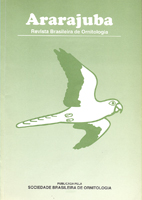
Reproductive biology and nest-site selection of the Mato Grosso Antbird Cercomacra melanaria in the Brazilian Pantanal
Abstract
Some economic activities, such as extensive cattle ranching, may seriously threaten the types of forest most important to the Mato Grosso Antbird Cercomacra melanaria, and information on reproductive biology is essential for defining sound conservation and management strategies of the species. In this work, the reproductive biology of this species has been studied in the Brazilian Pantanal with the main objective of understanding its reproductive attributes, such as incubation and nestling period, as well as characteristics of parental care. The hypothesis that nest occurrence is associated with canopy opening was also tested. Average nest height was 0.98 m; nest construction and egg incubation periods were 12.2 and 14 days, respectively; nestling period was 9.4 days. Both males and females participated in nest construction, egg incubation and feeding of nestlings. The canopy was consistently more open away from the nests (18.74%) than on nest sites (10.10%), p < 0.0001, suggesting that this species selects nest sites with dense vegetation.
Full Text:
PDF** The work of the Editor in Chief, Managing Office, Associate Editors, and the Editorial Council of Revista Brasileira de Ornitologia is strictly voluntary, and does not involve the use of any resources and infrastructure other than the personal ones**



